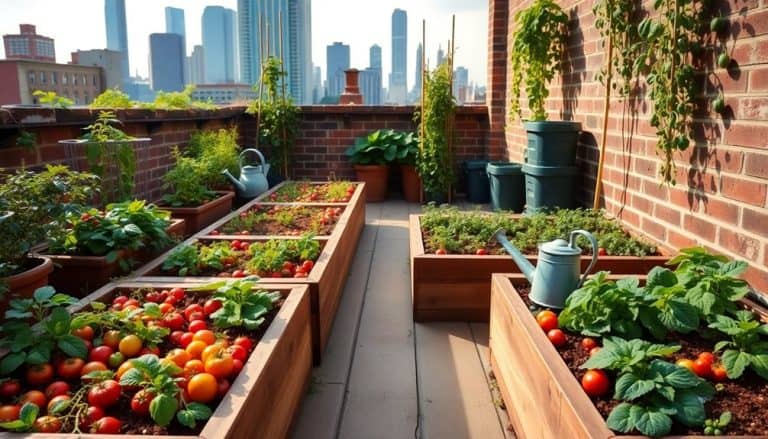This website contains affiliate links. Some products are gifted by the brand to test. As an Amazon Associate, I earn from qualifying purchases. The content on this website was created with the help of AI.
You’ll need six essential gardening tools to guarantee peak cultivation success in 2024. Start with a stainless steel hand trowel and garden fork set for precise soil manipulation and aeration. Add bypass pruning shears with high-carbon steel blades for clean plant maintenance cuts. Protect yourself with nitrile-coated gloves and UV-protective eyewear. Include a high-pressure adjustable nozzle and watering wand for targeted irrigation. Invest in a digital soil testing kit with Bluetooth connectivity for real-time pH and nutrient analysis. For heavy materials, select a dual-wheel wheelbarrow with a 300-pound capacity. These foundational tools represent just the beginning of your horticultural journey.
Key Takeaways
- Invest in high-quality hand tools including a stainless steel trowel and bypass pruning shears for essential planting and maintenance tasks.
- Protect yourself with nitrile-coated gloves, UV-protective eyewear, and steel-toed boots while working in the garden.
- Choose a durable garden hose with brass fittings and adjustable nozzle for efficient watering and plant care.
- Get a basic soil testing kit to understand your garden’s pH and nutrient levels for better plant growth.
- Purchase a wheelbarrow or garden cart with 4-6 cubic feet capacity for easy transport of soil, plants, and tools.
Hand Trowel and Garden Fork
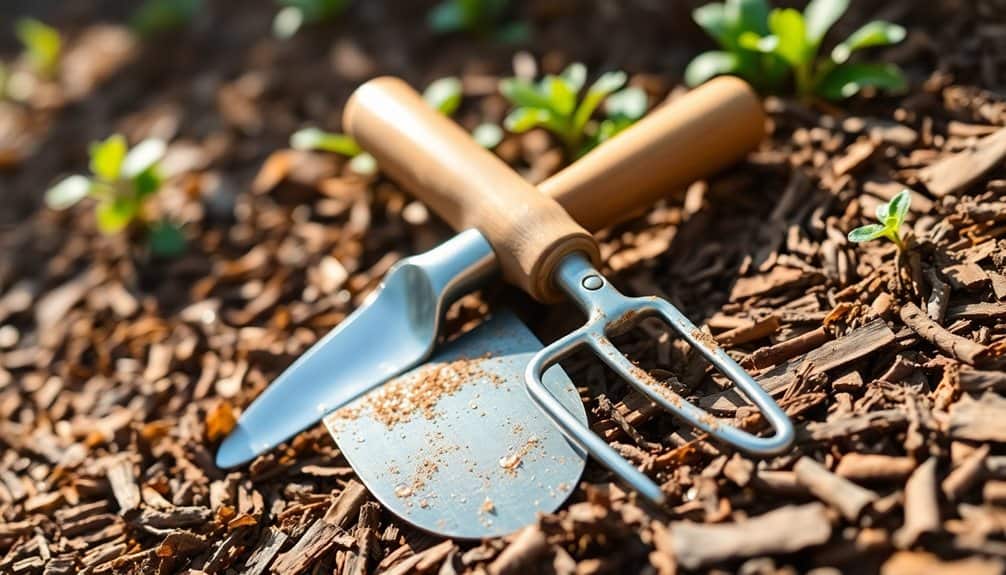
For virtually any gardening project, a hand trowel and garden fork serve as fundamental tools that you’ll need for essential tasks like planting, transplanting, and soil preparation. The hand trowel’s concave blade, typically 6-8 inches in length, enables precise soil displacement and creates ideal planting holes for seedlings or bulbs. You’ll want to select a trowel with a rust-resistant stainless steel blade and ergonomic handle to prevent fatigue during extended use.
The garden fork, with its multiple tines, excels at aerating compacted soil and breaking up dense root systems. When selecting a garden fork, opt for forged steel tines that won’t bend under pressure. The tines should measure 6-7 inches in length with sufficient spacing between them to prevent soil compaction during use. For enhanced control, you’ll need a D-shaped handle or straight shaft with non-slip grip.
To maintain these tools’ effectiveness, clean them after each use by removing soil residue and applying light oil to prevent oxidation. Store them in a dry location, and periodically inspect for loose handles or developing rust spots that could compromise their structural integrity. Consider using a garden utility cart to transport these tools and other equipment efficiently around your garden space.
Pruning Shears and Garden Scissors
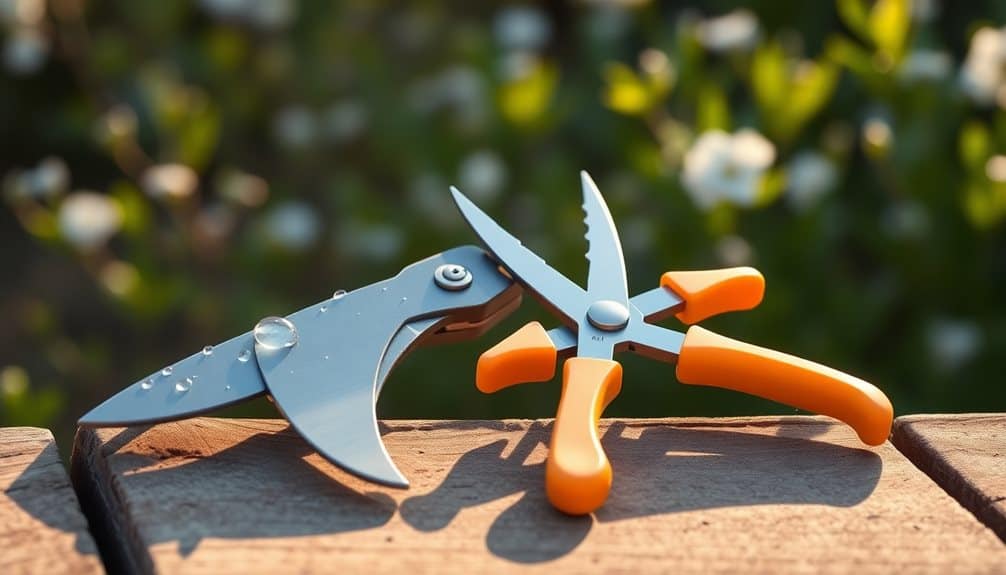
While hand tools prepare the soil, pruning shears and garden scissors tackle the critical task of plant maintenance above ground. These precision instruments serve distinct functions: pruning shears (secateurs) handle woody stems up to ½ inch in diameter, while garden scissors manage softer vegetation and detailed trimming tasks.
You’ll need bypass pruning shears for clean, precise cuts that promote rapid healing. Their scissor-like action prevents stem crushing and reduces the risk of disease transmission. When selecting shears, prioritize models with high-carbon steel blades and ergonomic handles featuring a safety lock mechanism.
Garden scissors, with their smaller blades and enhanced maneuverability, excel at deadheading spent blooms, harvesting herbs, and precise topiary work. Look for scissors with serrated edges to prevent material slippage during cuts. Both tools require regular maintenance: clean the blades with isopropyl alcohol after each use, and sharpen them quarterly using a diamond file at a 20-degree angle.
Store your cutting tools in a dry environment and apply penetrating oil to the pivot points monthly. This preventive care maintains peak performance and extends the tools’ lifespan, ultimately improving your pruning precision and plant health outcomes. The most reliable pruning shears feature SK5 carbon steel blades that resist rust and maintain sharpness through extended use.
Garden Gloves and Safety Equipment
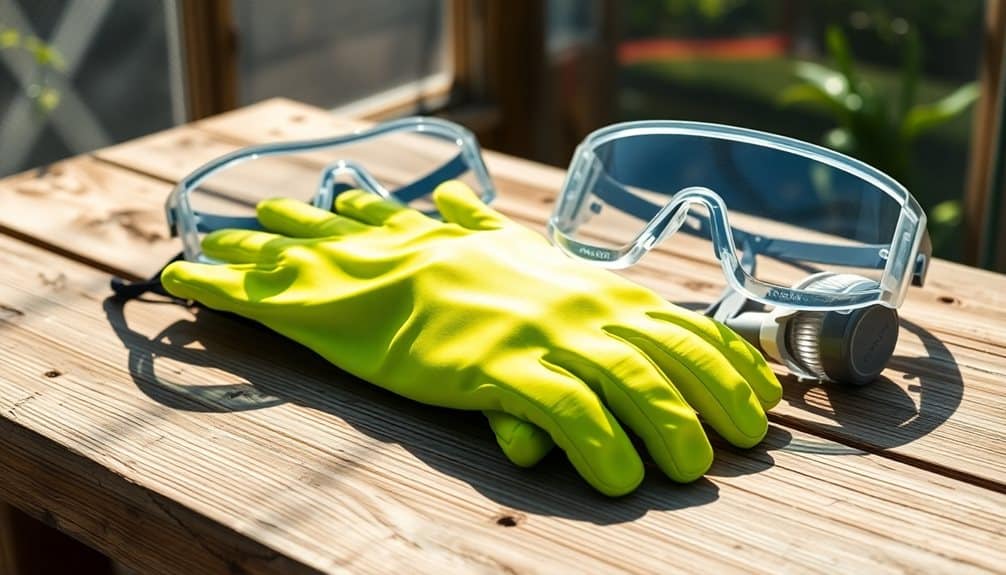
Proper safety equipment stands as the foundational defense against gardening hazards, with protective gloves being the primary barrier between your hands and potential injury. You’ll need to select gloves based on specific gardening tasks: nitrile-coated gloves for wet conditions, leather gloves for thorny plants, and puncture-resistant synthetic materials for general use.
Beyond hand protection, you’ll require UV-protective eyewear to shield against debris and harmful solar radiation while working outdoors. A broad-spectrum SPF 50+ sunscreen and UV-protective clothing with UPF 40+ ratings are essential for prolonged garden work. Don’t forget respiratory protection – an N95-rated dust mask prevents inhalation of soil particulates, fertilizer dust, and organic matter.
For lower body protection, you’ll need steel-toed boots or composite safety footwear that’s water-resistant and provides ankle support. When handling chemicals or fertilizers, utilize chemical-resistant gloves and protective goggles with side shields. During extended kneeling tasks, ergonomic knee pads with closed-cell foam padding will prevent joint strain and protect against soil moisture penetration. Store all safety equipment in a dry, ventilated location to maintain its protective properties. For optimal protection and longevity, replace your worn gardening gloves every 3-6 months with regular use.
Watering Tools and Rain Gauge
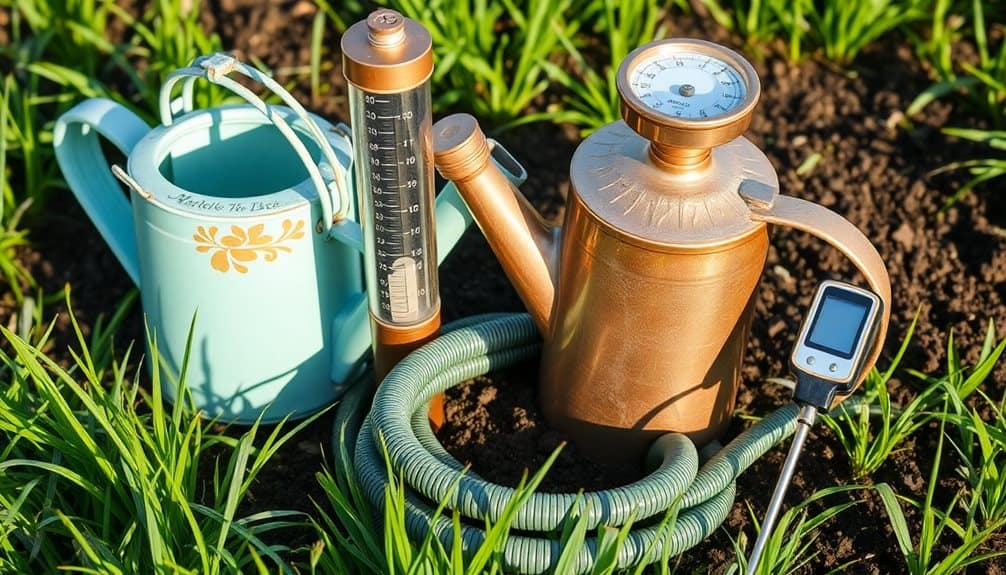
Armed with the right safety gear, you’ll need reliable watering equipment to maintain ideal soil moisture levels. Your essential watering toolkit should include a garden hose with adjustable nozzle, watering wand, and rain gauge to monitor precipitation levels accurately.
Select a high-quality expandable hose with brass fittings and a burst rating of at least 350 PSI. The nozzle should offer multiple spray patterns, including mist, shower, and jet settings, allowing precise control over water distribution. A watering wand with a shut-off valve extends your reach by 24-36 inches, enabling targeted irrigation of hanging baskets and deep garden beds.
Install a rain gauge in an open area, away from structures and vegetation. The gauge should measure precipitation in both millimeters and inches, with clear calibration marks at 0.01-inch intervals. For peak accuracy, position it 4-5 feet above ground level. Consider a digital rain gauge with wireless connectivity to track historical rainfall data and automate your watering schedule.
Supplement these tools with micro-irrigation components like drip lines and soaker hoses for water-efficient root zone irrigation. These systems operate at 10-30 PSI and deliver precise amounts of water directly to your plants. Modern marine-grade fabric construction makes today’s garden hoses 50% lighter while maintaining exceptional durability and kink resistance.
Wheelbarrow and Garden Cart

Moving heavy loads of soil, mulch, and garden materials calls for reliable transport equipment. A wheelbarrow or garden cart serves as an indispensable tool for efficiently transferring materials across your garden space while minimizing physical strain and preventing back injuries.
When selecting between a wheelbarrow and garden cart, consider these critical specifications:
- Single-wheel wheelbarrows offer superior maneuverability in tight spaces and precise load placement, with typical capacities of 4-6 cubic feet
- Dual-wheel wheelbarrows provide enhanced stability on uneven terrain and can support loads up to 300 pounds
- Four-wheel garden carts maintain balance without operator support and feature removable sides for oversized items
- Heavy-duty poly tubs resist rust and reduce overall weight compared to steel alternatives
- Pneumatic tires absorb shock and navigate rough terrain more effectively than solid rubber wheels
For maximum functionality, select a model with ergonomic handles positioned at waist height and verify the load capacity aligns with your intended use. When operating, maintain a 60/40 weight distribution between the wheel(s) and handles for controlled movement. Store your transport equipment in a covered area to extend its service life and prevent weather damage.
Modern Garden Soil Testing Kit
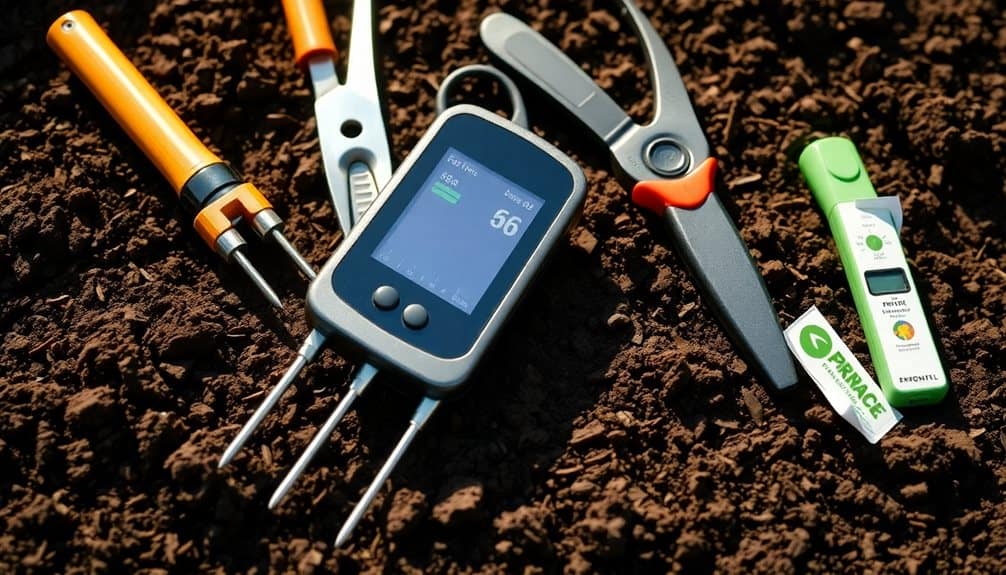
For accurate soil amendments and ideal plant growth, a modern soil testing kit provides essential data about your garden’s pH levels, nutrient content, and mineral composition. Today’s digital kits measure macronutrients (N-P-K), secondary nutrients (Ca, Mg, S), and micronutrients (Fe, Mn, Zn) with laboratory-grade precision.
You’ll need to collect soil samples from multiple garden zones, ensuring 4-6 inches of depth per sample. Most digital kits require 2-3 tablespoons of soil mixed with the provided solution. Insert the probes or testing strips according to the manufacturer’s specifications, and you’ll receive results within 10-15 minutes.
The kit’s LCD display will show pH readings (typically 0-14 scale), nutrient levels in parts per million (ppm), and soil conductivity measurements. Modern kits often include Bluetooth connectivity to sync data with smartphone apps, allowing you to track soil changes over time. You’ll receive specific amendment recommendations based on your results, such as adding lime to raise pH or sulfur to lower it. For accuracy, calibrate your testing equipment monthly and replace testing solutions annually. The most reliable dual stainless steel probes enhance durability and provide consistent readings across multiple soil types.
Frequently Asked Questions
How Often Should I Clean and Maintain My Gardening Tools?
Just as your teeth need daily brushing, your gardening tools crave regular care. You’ll need to clean your tools after each use by removing soil and debris, then thoroughly dry them to prevent rust. Every 1-2 months, apply lubricating oil to metal parts, sharpen blades, and inspect wooden handles for splinters. For seasonal storage, disinfect tools with 70% isopropyl alcohol and coat metal surfaces with protective oil.
What Is the Best Time of Year to Start a Garden?
The ideal planting period depends on your USDA hardiness zone and chosen cultivars. You’ll want to start cool-season crops (Brassica family, Allium species) 4-6 weeks before the last frost date. For warm-season plants (Solanaceae family, Cucurbitaceae family), initiate cultivation after soil temperatures reach 15-20°C (60-68°F). If you’re starting indoors, begin seed germination 6-8 weeks before transplanting outdoors, accounting for your region’s specific growing season.
How Much Should a Beginner Spend on Their First Set of Tools?
You’ll find that investing $100-150 in your initial gardening toolkit provides ideal cost-efficiency for beginners. Research indicates that allocating 60% to essential tools (pruning shears, trowel, spade) and 40% to supplementary items (garden fork, watering can, gloves) maximizes utility. Don’t fall into the trap of purchasing premium equipment; mid-range tools offer sufficient durability and precision for developing your horticultural expertise.
Can I Store My Gardening Tools Outside in a Shed?
You can store your tools in a shed, but you’ll need to implement proper moisture control and ventilation to prevent rust formation and degradation. Install a dehumidifier or moisture-absorbing products, maintain temperatures between 40-70°F, and guarantee tools are clean and dry before storage. Apply a protective coating of mineral oil to metal surfaces, and hang tools vertically to prevent contact with potentially damp floors.
Which Gardening Tools Are Most Likely to Need Replacement Within a Year?
You’ll need to replace several tools annually due to wear patterns and material degradation. Pruning shears typically require replacement after 8-12 months of regular use due to dulling blades and spring fatigue. Plastic-handled trowels and cultivators often deteriorate from UV exposure and soil abrasion. Garden gloves experience rapid deterioration through soil contact and moisture exposure, while natural-fiber marking twine biodegrades within a single growing season.



